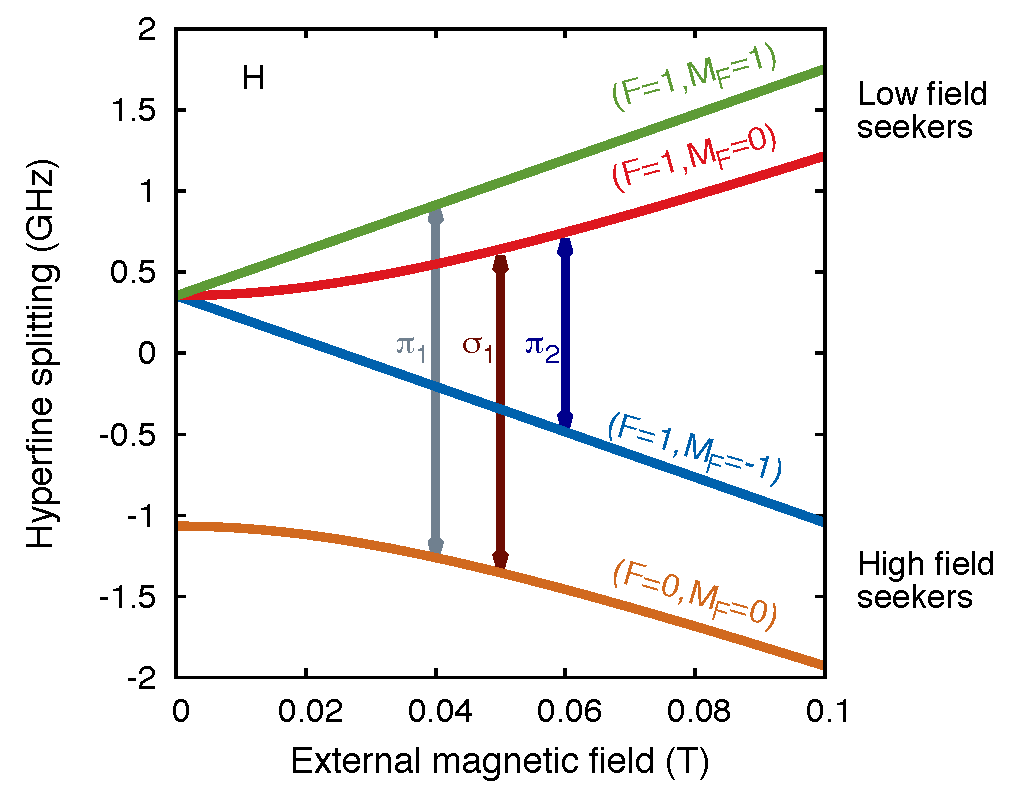1S-2S Laser spectroscopy

Experimental studies of H properties are of prime importance due to the possibility to calculate them theoretically from first principles. As the simplest of atoms, H has played a key role in revealing and testing fundamental laws of physics. Transition frequencies in H are proportional to the Rydberg constant (R∞), they account for QED corrections and the radius contribution of the nucleus charge distribution. The Rydberg constant, which is now deduced from H spectroscopy, is interesting as it is the scaling factor, which connects all theoretical calculations and energy level measurements in any system involving electrons (atoms, molecules and condensed matter). If we are able to improve its determination, this will impact all spectroscopy studies.
An essential limitation of spectroscopy of H is their large velocity. Since the advent in the 70s of tunable lasers and methods of Doppler-free spectroscopy, H optical spectroscopy has been renewed in the last decades, and several optical frequencies of H are now known with a fractional accuracy <10-11. However, H sources are still made of an atomic beam, most at room temperature, as was the case at the time of discovery of the 2S1/2-2P1/2 Lamb shift in 1947. The coldest H beam is nowadays at 4K with a mean velocity of ~300 m/s. By selecting the slowest atoms, the lowest velocity achievable is a few tens of m/s with a very small flux. A cold H source similar to those made for alkaline atoms has never been realized, as it requires a powerful light source at the wavelength of 121nm, which is out of reach for current laser technology. Recent proposals to cool H atoms using a 205nm picosecond laser or a powerful continuous laser at the wavelength of 243nm have been published but not yet demonstrated.
The source to be developed at UTU will ultimately provide H atoms with a velocity of few cm/s (~10nK). Thanks to the longest observation time of a large sample of H atoms at rest, we aim to improve hydrogen spectroscopy (1S-2S and 2S-nS/nD) and observe for the first time the natural line-width of the 1S-2S transition. With such a source we can also realized for the first time optical trapping of hydrogen at 514 nm.
Hyperfine spectroscopy

Hyperfine spectroscopy (HFS) of hydrogen and its isotopes has not been pursued since the advent of the maser in the 70s, but has generated strong interest recently, initially due to the opportunity of applying the techniques to antihydrogen, where the ground-state HFS offers one of the most sensitive tests of CPT symmetry. CPT is a cornerstone of the Standard Model of particle physics (SM) as its conservation rests on a mathematical theorem based on the properties of quantum field theories (QFT) used in the SM. Both the apparent absence of antimatter in the universe, and the fact that theories beyond the SM such as string theory lack the mathematical structure needed for the CPT theorem, require testing of this fundamental symmetry’s validity.
The H spectroscopy alone also offers access to this question, since one of the conditions of the CPT theorem is Lorentz Invariance (LI). The only phenomenological model describing possible CPT violations within QFT is the SM Extension (SME) by Kostelecky et al. which parametrizes LI and thus CPT violation. For H, bounds on SME coefficients have been obtained from maser measurements at a level of ~10–27 GeV. In the recently developed non-minimal version of SME, additional coefficients were introduced that depend on the orientation of an externally applied constant magnetic field Bext, which have not yet been constrained by any measurement. A further interest arises in analogous HFS measurements with detuterium (D), since, due to the Fermi-momentum of the proton in the D nucleus, the sensitivity to certain SME coefficients is enhanced by orders of magnitude.
The highest precision for HFS spectroscopy in a beam was obtained by a team of scientists from SMI and CERN using a 50 K beam, yielding an accuracy of 3.8 Hz. H atoms from the magnetic trap at much lower velocities (10 cm/s) will be used to push the microwave spectroscopy to a level of H maser, thus improving the precision ~103 times and constraining SME coefficients with 10-21 GeV accuracy. For D, no results of SME coefficients are available at all, so these measurements will be the first ever and will yield similar precision in the case of H.
